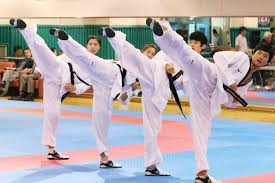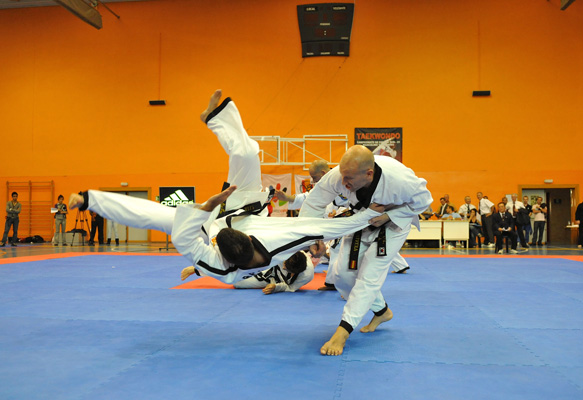The history of Taekwondo and other martial arts are old and rich. There are royal tombs from Korea’s ancient past with murals in which figures could either be dancing or fighting. In fact, even today, some of the martial art’s formalized movements are dance-like. Scholars think Taekwondo derives some of its movements from Chinese martial art. And that the origins of taekwondo may have been in the military, through many different martial art forms.
The martial art came out of Koguryo (37 BC to 668 CE), which was one of Korea’s three big kingdoms even before Christ.
The kingdom grew out of the continual conflict with the Chinese. Naturally, the local culture was quite full of fighting and military traditions so they could always one-up the Chinese warriors.
Next, it was the Silla kingdom (356 CE to 935) that inherited a martial art known as Tae kyon.

Taekwando Fighters
So far, it had been in its infancy, among the military. But it is believed that young Silla scholar-warriors who were called Hwarang took it up, evolved it and made it popular. These scholars traveled the Korean peninsula, studying its people and places. There seems to be a lot of romance associated with these Hwarang -they’ve been called the Flowering Knights, and may have been pretty young men in their teens, rather like the “idols”of Korean pop today.
These men were supposed to be perfect models of virtue for the kingdom. They had to be loyal to the king, be respectful, obedient and loyal to their parents, be faithful in friendships, never kill without justification and never retreat in battle. They were also trained in music, dance, Confucianism, Buddhism and poetry.
I think I see why Taekkyeon is dance-like. It is also the only Korean martial art that has made it to the UNESCO list of Intangible World Heritage Artforms.
A lot of these martial arts were looked down upon during the Joseon Dynasty (1392 -1897).
Confucianism came to Korea and scholars were valued over fighters. So Taekkyon was banned among the public and became something of an underground folk culture especially in the 19th century. A lot of the masters of taekkyeon taught their skills secretly, constantly in fear of imprisonment.
Taekwondo on the other hand is very new. It was developed formally as recently as the 1940s and 1950s.

Masters Demo Tang Soo Do
But it’s probably been evolving for a lot longer, from Chinese martial arts and ancient Korean traditions as well. Taekwondo is all about kicking -fast kicks, spinning and jumping kicks, head-high kicks.
Taekkyeon also uses kicks. But the movements are fluid and beautiful, and the footwork is based on a system called pum balgi, which literally translates to Stepping On Triangles. Arm movements are integrated with the footwork. There are also many whole-body techniques, arm strikes and punching along with kicks, many kinds of throws, grappling and takedowns. The focus, however, is on striking.
These are some of the other Korean martial arts:
Tang Soo Do
Another striking martial art that also emphasizes kicking. But it is practiced today more as a form of self-defense than a sport. It has a controversial history, since its master Hwang Kee derived some of the movements in Tang Soo Do from karate. After the Japanese occupation, the Koreans wanted to rename their martial arts. But Hwang Kee refused to change his artform and was forced to move to the US. Tang Soo Do is also called Soo Bahk Do.
Hapkido

Hapkido
This art of grappling is quite modern. It has some Japanese origins mixed with striking techniques from Korea.
If you want to learn Korean martial arts, I suggest you check out the different taekwondo programs.
If you’re interested in Taekyeon, check out the Kyulyun Taekkyeon Association in Seoul.
You could also consider joining a Fight Camp Travel package for training in Korean martial arts.
Do you have experiences as an expat training in Korean martial arts? I’d love to hear from you in the comments section below!
